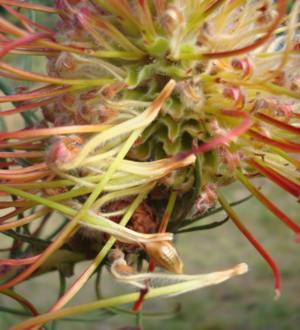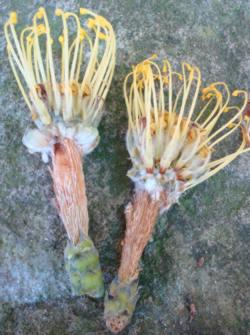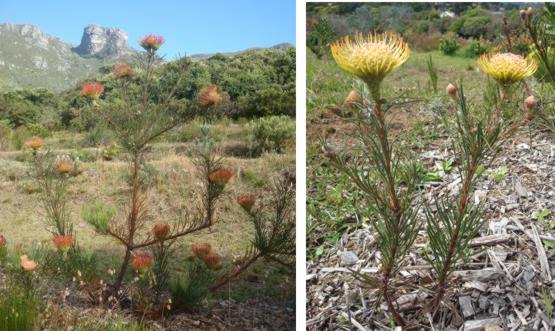Leucospermum lineare
Leucospermum lineare R.Br.
Family: Proteaceae
Common names: needle-leaf pincushion, narrow-leaf pincushion, tangerine pincushion, assegaaibos pincushion (Eng.); smalblaarspeldekussing, luisiesbos (Afr.)
Introduction
Leucospermum lineare is a medium-sized shrub well suited to a larger, informal garden. The yellow sprawling form can also be planted in pots.

Description
Description
There are two distinct forms of Leucospermum lineare, but they are not formally recognized as separate subspecies. The orange-flowering form is an erect shrub reaching 2 m tall. The yellow-flowering form has a sprawling habit and grows 2 m tall and 2-3 m across.

Leaves of both forms are thin and needle-like measuring 40-100 mm long and 2-7 mm wide.

Flowerheads are 60-90 mm in diameter. Generally they are solitary but can be borne in groups of two or three. Flowering occurs mainly in spring (September and October), but odd flowers do appear anytime from winter to mid-summer (July to January).
Seeds take about 2 months to ripen after flowering before being released.
Conservation Status
Status
Leucospermum lineare is listed as Vulnerable. The population is decreasing due to invasive alien vegetation, harvesting of cut flowers and habitat loss due to land transformation.
Distribution and habitat
Distribution description
The needle-leaf pincushion grows mostly in Boland Granite Fynbos at altitudes of 300-1000 m. Soils are heavy clay. Summers are hot and dry and winters cool and wet. The average annual rainfall is 985 mm and mean daily maximum and minimum temperatures are 26.6°C and 5.9°C. Frost is rarely experienced occurring on 2 or 3 days per year.
The yellow form is fairly common, occurring from Bain's Kloof through to the Du Toitskloof and Hottentots Holland Mountains. The orange form is known only from a single population growing in the Franschhoek Mountains.
Derivation of name and historical aspects
History
The genus name Leucospermum is derived from the Greek word 'leukos', meaning white and 'sperma', meaning seed. The seeds are black but coated with a white fleshy covering called an elaiosome. The Afrikaans common name 'luisiesbos ' is named after the appearance of this elaiosome which resembles lice, or in my opinion, fat ticks!

Lineare alludes to the needle-like leaves; the defining characteristic for this species.
Ecology
Ecology
After birds have pollinated the flowers seeds ripen and fall to the ground. The elaiosome coating on the seed is a very attractive food source for indigenous ants that collect the seeds and take them underground to their nests. They eat off the elaiosome and the seed is snuggly planted underground where it is safe from predation and fire. This is known as myrmecochory. Mature plants are killed by fire (re-seeders) and rely on the ants to bury their seeds so that they can germinate after fire.
At Kirstenbosch the exotic gray squirrel has become a bit of a pest as they eat all the seeds from flowerheads before they get a chance to drop to the ground and often even before they are ripe!

Uses
Use
Leucospermum lineare has been extensively hybridized and selected as it is a prized cutflower. It has been crossed with Leucospermum tottum, L. vestitum and L. cordifolium to produce an excellent variety of hybrids that are tough in cultivation and easy to grow in your garden.

Growing Leucospermum lineare
Grow
Leucospermum lineare can be propagated from cuttings or seed; both methods are successful. This is one of the fastest flowering Leucospermum species, and if plants are thriving they can flower in their second year of growth.
Take cuttings from December to March (summer to autumn). The cuttings should be semi-hardwood, 60-100 mm long, and taken from the current season's growth. Dip the cuttings into a rooting hormone solution or powder and plant into a medium of 50% polystyrene and 50% finely milled pine bark. Place in a growing house with bottom heat (25ºC) and intermittent mist. Once the roots are well developed, remove from the mist unit and harden off for three weeks. Plant the cuttings into small bags and grow on until ready to plant into the garden.
Sow seed at the end of February when the days are warm and the nights start to cool down (late summer to autumn). Soak seed in smoke water to which hydrogen peroxide has been added at the ratio of 1% of the total volume, for 24 hours. This loosens the outer seed coat and oxygenates the seed. After soaking, rub off the softened seed coat. Dust the seed with a systemic fungicide. Sow on a well-draining medium, firm down and cover with a layer of sand. Seed can be sown in an open seedbed, or in a seedtray placed in a sunny position. Germination begins after three to four weeks. Once two true leaves have sprouted, prick the seedlings out into small pots. The seedlings will have to be pricked out in batches, as the seeds germinate at different times. Place the seedlings in a lightly shaded area with good air circulation. When plants are ± 50-100 mm tall or after one year's growth, they can be planted into the garden. Nipping out the tips will encourage branching and produce a neater shrub.
Plant out into the garden at the start of the rainy season. This enables plants to establish themselves and send down deep roots before the hot, dry summer season. Granite soils are richer in nutrients than sandstone soils, so incorporate a good amount of well rotted compost at planting. Feed with an organic fertilizer low in phosphates (for example 5:1:5) twice a year in spring and autumn. Ensure that the soil stays cool and retains moisture in the hot months by using a thick layer of mulch or groundcover planting.
Pests are not too much of a problem, but if air flow and circulation are not sufficient, mealy bug and scale may appear. Improve exposure to wind/air flow and treat with an appropriate insecticide or biological control.
Phytopthora is a soil-borne fungus that affects most members of the protea family. Stems wilt and plants turn brown very quickly. Unfortunately, by the time plants show signs of this disease, it is too late and it is best to remove them to stop the infection spreading.
References
- Rebelo, A. (Tony). 2001. Proteas. A field guide to the proteas of southern Africa , edn 2 . Fernwood Press, Cape Town.
- Rebelo, A.G., Helme, N.A., Holmes, P.M. et al . 2006. Leucospermum lineare R.Br. National Assessment: Red List of South African Plants version 2012.1.
- Rourke, J.P. 1972. Taxonomic studies on Leucospermum R.Br . Compton Herbarium. National Botanic Gardens of South Africa. Kirstenbosch.
- Vogts, M. 1982. South Africa's Proteaceae, know them and grow them . Struik, Cape Town.
- Website: Plants of southern Africa: an online checklist. http://posa.sanbi.org.
- Website: Protea Atlas Project. http://protea.worldonline.co.za/lscath.htm
Credits
Louise Nurrish
Kirstenbosch National Botanical Garden
January 2013
Plant Attributes:
Plant Type: Shrub
SA Distribution: Western Cape
Soil type: Sandy, Clay, Loam
Flowering season: Spring
PH: Acid, Neutral
Flower colour: Red, Yellow, Orange
Aspect: Full Sun
Gardening skill: Challenging
Special Features:
Horticultural zones







Rate this article
Article well written and informative
Rate this plant
Is this an interesting plant?
Login to add your Comment
Back to topNot registered yet? Click here to register.